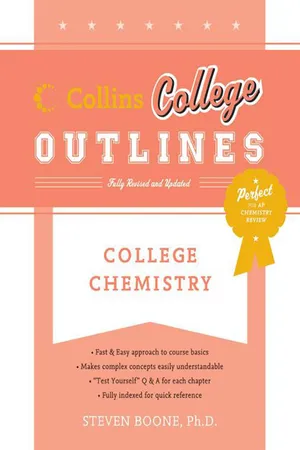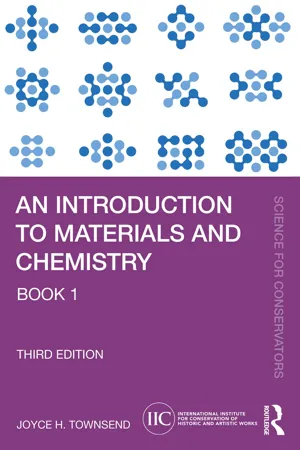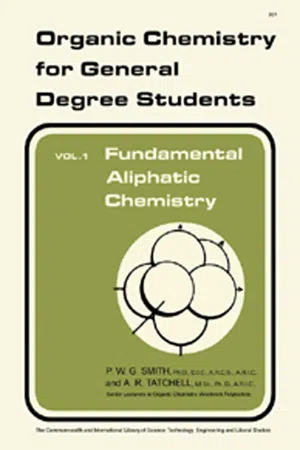Chemistry
Mechanisms of Chemical Bonding
Mechanisms of chemical bonding refer to the ways in which atoms are held together in a compound. This includes ionic bonding, where electrons are transferred between atoms, and covalent bonding, where electrons are shared. Additionally, metallic bonding involves a sea of delocalized electrons surrounding positively charged metal ions. Understanding these mechanisms is crucial for comprehending the properties and behavior of different substances.
Written by Perlego with AI-assistance
Related key terms
Related key terms
1 of 4
Related key terms
1 of 3
6 Key excerpts on "Mechanisms of Chemical Bonding"
- No longer available |Learn more
- Steven Boone, Drew H. Wolfe(Authors)
- 2011(Publication Date)
- Collins Reference(Publisher)
CHAPTER 10Chemical Bonding: Fundamental Concepts
A chemical bond is the force of attraction that one atom (or ion) has for another atom (or ion). The principal driving force for atoms to combine and form molecules is the release of energy by atoms as they stabilize through bonding. The two principal types of bonds discussed in this chapter are ionic and covalent bonds.10.1 INTRODUCTION TO CHEMICAL BONDINGChemical bonds are the forces that hold atoms together when compounds are formed. Ionic or Electrovalent BondsIonic bonds most commonly result when one or more electrons transfer from a metal to a nonmetal. When this occurs, the metal atom becomes a cation, and the nonmetal atom becomes an anion. Ionic bonds are the electrostatic forces of attraction among the resulting positive and negative ions.Covalent BondsA covalent bond results when the orbitals of two nonmetal atoms overlap and the nuclei of the atoms attract the electrons in the overlapping region. This is called electron sharing .Bonding TheoriesThe valence bond and molecular orbital theories are most often used to explain the properties and formation of chemical bonds. The Valence Bond Theory primarily considers the interactions of the electrons in the outer shell (valence electrons) in the formation of bonds. The Molecular Orbital Theory considers the energies of all the electrons in the atoms that form chemical bonds. Scientists use both theories to explain chemical bonds and molecular structures, because neither can explain adequately the bonds in all chemical species.Lewis Symbols and Lewis FormulasThe valence electron configurations of the atoms are often shown using Lewis symbols and Lewis structures. To write the Lewis symbol of an atom, place as many dots around its symbol as there are valence electrons. For example, one way to write the Lewis symbol of N is shown in Figure 10.1. Five dots are placed around the symbol of nitrogen because it has five valence electrons, 2s2 2p3 - eBook - ePub
- Joyce H. Townsend(Author)
- 2023(Publication Date)
- Routledge(Publisher)
For elements heavier than calcium the regularity of this periodic pattern is distorted. Look at the periodic table at the back of this book. Although it is not regular, the full periodic table can still be explained systematically in terms of the numbers of electrons in different types of orbital. To explain the mechanisms of valency, without too much complication, only the first two rows of the table will be used here. The ways in which bonds are formed vary according to which of these classes of atoms are brought together. Several types of combination will now be looked at in turn.C Bonding mechanisms
C1 Covalency: bonding by sharing
Methane is a molecule containing two elements that both have atoms possessing half-full outermost electron shells. It is an example of a molecule made by atoms sharing electrons. Bonds formed by this mechanism are called covalent bonds . Figure 4.3 represents the atoms of hydrogen and carbon diagrammatically, showing the electron shells and their electrons.Figure 4.3Electronic structure of hydrogen and carbon, shown in two dimensions.Figure 4.4 shows a model of the methane molecule, demonstrating the origin of the electrons forming the bonds between the atoms by using the same symbols. The first shell of each hydrogen atom is made complete by sharing one electron from the carbon. The first shell of the carbon atom is already full. The second shell of carbon is made up to its full complement of eight electrons by sharing one electron from each hydrogen atom. You will notice that the electrons in the two atoms have been represented by two differently coloured symbols. This has been done purely to illustrate the origin of the electrons when full shells have been formed by sharing. It is important to remember, however, that all electrons are in reality identical.Figure 4.4Full electronic structure of methane, shown in two dimensions with contributory electrons.These models are not drawn in exactly the same way in every book you read but you will always be able to see shared electrons. A common form for diagrams such as these suppresses the superfluous information about the inner full shells and presents methane as shown in Figure 4.5 - eBook - ePub
- Mukesh Doble, Anil Kumar Kruthiventi, Vilas Ganjanan Gaikar(Authors)
- 2004(Publication Date)
- CRC Press(Publisher)
Thus, if more than two atoms combine, we get an electron cloud distributed aross all the nuclei of the atoms. The shape of this electron cloud is distinct and unique to a molecule. That is, say, methane—all of methane molecules have the same electron cloud distribution, but the electron cloud distribution of methyl chloride is different from methane, as shown in Fig. 2.1. In fact it is this unique electron cloud distribution over a molecule that determines its reactivity. 2.1.3 Concept of Chemical Bonding These notes are designed to give a quick guide to bonding—there is a lot more to this subject than is covered here. The forces that hold atoms together within chemical compounds, the chemical bonds, are electrical in nature. Chemical bonds form to lower the energy of the system, the components of the system becomes more stable through the formation of the bonds. This is true even for noncovalent interactions (hydrogen bond, van der Waals interaction, electrostatic interaction, etc.), which are far more important among biomolecules and supramolecular aggregates. These bonding and noncovalent interactions are Nature’s way of attaining greater stability. The development of a sound chemical bonding theory started with the idea put forth by G.N.Lewis in 1916, that bonding results from a sharing of electron pair between two atoms. Two major bonding interactions are common in Organic chemistry: one in which the two atoms constituting the bond share the two electrons, a covalent bond (Fig. 2.2), and the other in which one of the atoms constituting the bond takes both the electrons and attains a negative charge while the other atom loosing an electron attains a positive charge (“sharing” is unequal), an ionic bond (Fig - eBook - ePub
- Jeffrey Gaffney, Nancy Marley(Authors)
- 2017(Publication Date)
- Elsevier(Publisher)
Chapter 3Chemical Bonding—The Formation of Materials
Abstract
This chapter covers chemical bonding between atoms and ions and how this affects the chemical properties of the elements. Which elements form ions and the typical charges on the ions are explained. Ionic bonding and covalent bonding are compared in terms of the octet rule and valence bond theory. Polar and nonpolar covalent bonds are explained and their relationship to both electron group geometry and molecular geometry is stressed. Polyatomic ions are described as a mixed ionic, covalent species. Molecular orbital theory is introduced to explain magnetism, bond order, and hybridization, which will be important in later discussions of the chemistry of carbon. Intermolecular forces, including hydrogen bonding, are discussed with a special Case Study focusing on the special properties of water.Keywords
Ionic bonding; Covalent bonding; Octet rule; Polyatomic ions; Dipole moment; Molecular orbitals; Hybridization; Resonance; Molecular geometry; Intermolecular forcesOutline3.1Atoms and Ions3.2Ionic Bonding3.3Covalent Bonding3.4Mixed Covalent/Ionic Bonding3.5Molecular Orbitals3.6Molecular Geometry3.7Molecular Polarity3.8Intermolecular ForcesImportant TermsStudy QuestionsProblems3.1 Atoms and Ions
A neutral atom that loses one or more electrons becomes a positively charged ion. This positively charged ion is known as a cation (from the Greek word katá , meaning “down”). A neutral atom that gains one or more electrons has a negative charge and is known as an anion (from the Greek word ánō , meaning “up”). The number of electrons an element will gain or lose is also a periodic property and can generally be predicted from its position in the periodic table as shown in Fig. 3.1 . Atoms will gain or lose electrons to form ions that have electronic configurations which are more stable than the electronic configurations of the parent atoms. For most elements, this means that they will either gain or lose the number of electrons needed to achieve a closed valence shell. Remember from Table 2.9 of Chapter 2 - eBook - ePub
- Sir Alan Cottrell(Author)
- 2019(Publication Date)
- CRC Press(Publisher)
Chapter 4Chemical Bonding
4.1 Forces between atoms
The physical meaning of chemical affinity is that an attractive force exists between the atoms. There is also a repulsive force at close range which is the basis of the ‘impenetrability’ of matter. The equilibrium spacing of a pair of atoms is that at which these two forces are equal. Because force is rate of change of energy with distance, the energy of interaction of the pair reaches its lowest value at the equilibrium spacing. Quantum mechanics deals directly with energy, not force, and so it is usual to discuss problems of chemical bonding in terms of energy.We bring two atoms together from infinity, having defined their potential energy of interaction as zero at infinity. Little happens and the energy stays near zero until the atoms are within about an atomic spacing of each other. As they move still closer, the attractive force begins to be felt and the potential energy falls, since work is being done by the atoms as they move together under this force. When they get really close, the short-range repulsive force then also comes into play and soon dominates the attractive force. The potential energy rises at this stage since the atoms are now being pushed together. This behaviour is shown in Fig. 4.1 which gives the potential energy due to the attractive (curve a), repulsive (curve b) and total (curve c) forces as a function of the distance between nuclei. The potential energy ‘well’ is deepest at the equilibrium spacing r and its depth D there is equal to the work required to dissociate the atoms completely.Whether a collection of such atoms will form a gas or condense together into a liquid or solid depends both on D (in relation to the temperature and pressure) and on the nature of the forces. Molecular gases can form even when D is large (e.g. H2 , O2 , N2 , CO2 , at room temperature) if the atomic forces show saturation - eBook - ePub
Fundamental Aliphatic Chemistry
Organic Chemistry for General Degree Students
- P. W. G. Smith, A. R. Tatchell(Authors)
- 2014(Publication Date)
- Pergamon(Publisher)
IIAtomic Structure and Chemical Bonding
Publisher Summary
This chapter discusses atomic structure and chemical bonding. The wave-mechanical treatment of the hydrogen atom leads to a definition of a series of electronic energy levels or orbitals that a single electron can occupy. The orbitals are grouped into shells and are designated by a principal quantum number. The size of an orbital is determined by the principal quantum number, while its shape is indicated by the subsidiary classification. Each orbital can accommodate two electrons, which must be distinguished by having opposite spins; such electrons are said to be paired. The order in which the orbitals of equivalent energy are filled is governed by Hund’s rules. The chapter discusses the types of chemical bonding. The total number of electrons in the outermost shell is, with the exception of helium, eight. The completed octet must represent a stable electronic configuration. The three ways in which atoms can achieve this state give rise to the concepts of electrovalency or the ionic bond, covalency or the covalent bond, and co-ordinate covalency or the dative bond.The views on the structure of atoms which are accepted today have developed from Rutherford’s initial concept (1910) of the atom as a central, heavy, positively charged nucleus, surrounded by electrons (extra-nuclear electrons) of such a number as to achieve electrical neutrality. These electrons were assigned by Bohr (1913) to definite circular or elliptical paths (orbits) each corresponding to a particular energy level. Modern theory recognizes that if the energy level of an electron is known accurately, its position cannot simultaneously be accurately defined (the Heisenberg uncertainty principle), but can only be expressed as a mathematical probability defined by wave-mechanical equations. This treatment has led to the idea of an electron tracing a fixed orbit being replaced by the concept of an electron occupying an orbital.
Index pages curate the most relevant extracts from our library of academic textbooks. They’ve been created using an in-house natural language model (NLM), each adding context and meaning to key research topics.
Explore more topic indexes
Explore more topic indexes
1 of 6
Explore more topic indexes
1 of 4





